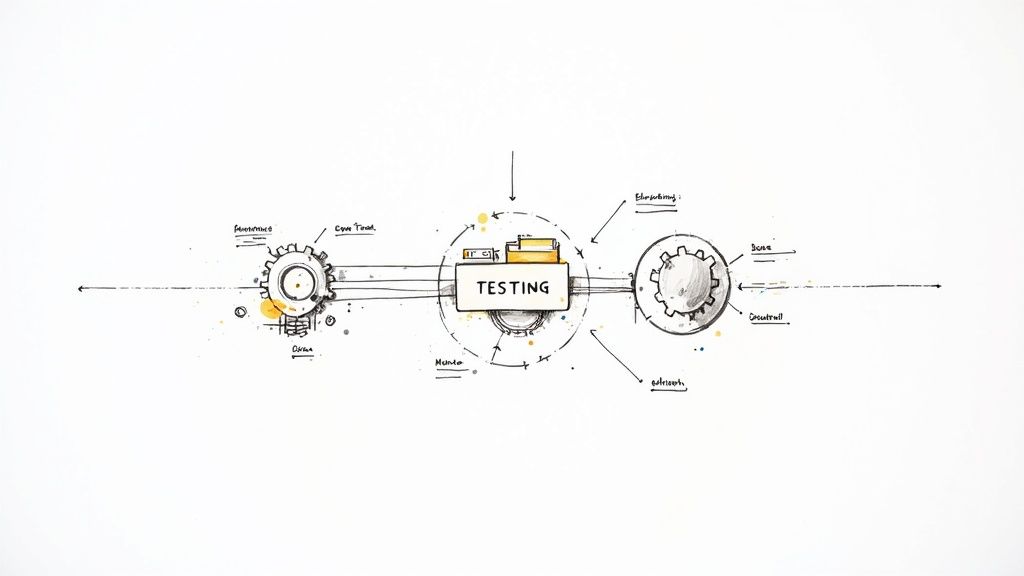Web site quality assurance: Proven Strategies

Why Website Quality Assurance Matters Now
For many organizations, website quality assurance (QA) might seem like an afterthought—something to address after the site is live. However, in today's competitive online market, this approach can be a significant disadvantage. Forward-thinking companies understand that robust website quality assurance is a critical part of their overall digital strategy, directly impacting their bottom line. Effective QA is no longer a simple bug hunt; it's a core business advantage.
The Business Impact of Quality Assurance
A high-quality website builds user trust. When a site functions smoothly, loads quickly, and provides a seamless user experience, visitors are more likely to engage, explore, and convert. Conversely, a poorly performing website filled with errors erodes user confidence and drives potential customers away, resulting in lower conversion rates and lost revenue.
Website quality assurance also plays a vital role in brand perception. A well-maintained website reflects professionalism and attention to detail, signaling to users that a company values its online presence and its customers. A website plagued by broken links, outdated content, and functional errors can severely damage a brand’s reputation and credibility.
The software testing industry, which includes website quality assurance, surpassed $45 billion in 2023. This growth highlights the increasing importance of software reliability and performance. Find more detailed statistics here: Learn more about software testing industry growth.
Beyond Bug Hunting: A Comprehensive Approach
The scope of website quality assurance has broadened significantly. It's no longer just about finding and fixing bugs. Modern QA encompasses a variety of activities, including:
- Usability Testing: Evaluating how easy and user-friendly the site is.
- Performance Testing: Assessing the site's speed, stability, and responsiveness under various loads.
- Security Testing: Identifying and mitigating vulnerabilities to protect user data and prevent cyberattacks.
- Accessibility Testing: Ensuring the site is usable by people with disabilities.
- Compatibility Testing: Verifying the site functions correctly across different browsers, devices, and operating systems.
By adopting a comprehensive approach to website quality assurance, businesses can create online experiences that not only meet but exceed user expectations, leading to greater online success.

The Testing Toolkit: What Actually Works
Website quality assurance (QA) is a practical pursuit, demanding a hands-on approach. But which testing methods truly deliver? Drawing on insights from seasoned QA experts, let's explore the essential testing types and how to implement them effectively. This involves understanding how each method contributes to a robust website, from identifying hidden usability issues to ensuring smooth performance across different devices.
Usability Testing: Uncovering the Unseen
While website analytics offer valuable quantitative data, usability testing reveals the why behind user behavior. It assesses how real users interact with your website, pinpointing pain points and friction areas that analytics might miss. For example, a high bounce rate on a particular page could stem from confusing navigation, unclear calls to action, or even distracting design elements. Usability testing provides the qualitative data necessary to identify and address these issues, ultimately optimizing the user experience.
Performance Testing: Beyond Speed
Performance testing is essential for ensuring your website handles traffic spikes gracefully and maintains a positive user experience under pressure. However, it often reveals more than just speed bottlenecks. This type of testing can uncover underlying architectural flaws, database limitations, and other technical issues affecting overall stability and scalability. By addressing these, you not only improve speed but also strengthen your website's foundation.
Compatibility Testing: Preventing Post-Launch Disasters
Compatibility testing confirms your website functions correctly across various browsers, devices, and operating systems. This is crucial in today's diverse digital landscape, where users access websites from a multitude of platforms. A website that looks perfect on a desktop computer might be unusable on a mobile device due to layout inconsistencies or unresponsive design. Compatibility testing prevents these costly post-launch problems by proactively identifying and resolving cross-platform issues. For further insights on website audits, check out this helpful resource: How to master a website audit.
To help illustrate the various types of web QA testing, the following table provides a comparison of different methodologies, their primary purposes, ideal implementation timing, and potential business impact.
Web QA Testing Types: What You Need to Know
This table compares different types of website quality assurance testing methodologies, their purposes, ideal implementation timing, and business impact.
| Testing Type | Primary Purpose | Implementation Stage | Business Impact | Automation Potential |
|---|---|---|---|---|
| Usability Testing | Evaluate user experience and identify areas for improvement | Design & Development / Post-Launch | Increased conversion rates, reduced bounce rates, improved customer satisfaction | Medium |
| Performance Testing | Assess website speed, stability, and scalability under load | Development / Pre-Launch | Improved website performance, reduced downtime, enhanced user experience | High |
| Compatibility Testing | Ensure consistent functionality across different browsers, devices, and operating systems | Development / Pre-Launch | Wider audience reach, improved brand consistency, reduced customer support issues | High |
| Functional Testing | Verify that all website features and functionalities work as expected | Development | Bug-free software, improved quality, reduced development costs | High |
| Security Testing | Identify and mitigate vulnerabilities to protect sensitive data and prevent attacks | Development / Ongoing | Enhanced data security, improved customer trust, reduced risk of breaches | Medium |
As the table shows, each type of testing plays a unique role in ensuring overall website quality. Prioritizing and implementing these tests strategically can significantly reduce risks and contribute to a successful online presence.
Putting it All Together: A Multi-Faceted Approach
Effective website quality assurance necessitates a combination of testing methods. Each approach provides unique perspectives on your website's performance and user experience. Furthermore, interpreting test results in a way that resonates with both technical and business stakeholders is vital. This means translating technical findings into actionable recommendations that clearly demonstrate the value of QA investments. By adopting a multi-faceted testing strategy, you can identify and address critical issues before they affect your users, ultimately leading to a stronger online presence and improved business outcomes.
Automating Quality: Beyond The Hype

The allure of automating website quality assurance is undeniable. However, a strategic approach is crucial. Completely automating every test can be counterproductive, leading to higher overhead and diminishing returns. Successful organizations carefully choose which tests are best suited for automation, recognizing the continued importance of human oversight. This balanced approach optimizes efficiency while preserving valuable human insights.
Identifying Automation Opportunities
Some tests are perfect for automation. Regression testing, for instance, ensures new code changes haven't introduced bugs or disrupted existing functionality. Automating these repetitive tasks allows QA specialists to focus on more intricate exploratory testing. Likewise, load testing, which evaluates website performance under stress, greatly benefits from automation, enabling simulated scenarios and precise performance measurements.
However, not every test is ideal for automation. Usability testing, for example, involves observing real users interacting with the website and gathering qualitative data on their experience. While some aspects can be automated, the subtleties of human behavior and subjective feedback often require a human touch. This careful consideration leads to comprehensive website quality assurance.
Sustainable Automation Strategies
Effective automation goes beyond selecting the right tools. It requires a sustainable strategy that aligns with team skills and budget constraints. Organizations should prioritize automation efforts based on their specific needs and available resources, concentrating on areas where automation delivers the most substantial impact. This might involve training team members in automation techniques or carefully choosing tools that seamlessly integrate with existing workflows. For a broader view of testing resources, consider exploring a guide on various software testing tools.
Overcoming Automation Pitfalls
Automation can present unique challenges. Maintenance overhead is a common concern, as automated tests need regular updates and adjustments to remain effective as the website evolves. False positives, where tests incorrectly identify non-existent issues, can also waste valuable time and resources. Successful organizations tackle these challenges by implementing robust monitoring and reporting systems and establishing clear procedures for test maintenance and validation.
Furthermore, the use of AI and machine learning in website quality assurance is growing. Autonomous testing, powered by these technologies, is now being adopted by over 50% of organizations. AI applications can analyze software usage patterns to automate specific testing tasks, leading to improved accuracy. Learn more about this trend by exploring further insights on AI in QA testing. By addressing these challenges proactively, organizations can create sustainable and scalable testing programs that consistently produce high-quality websites.
Integrating QA Into Your DevOps Pipeline
Integrating website quality assurance into your DevOps pipeline is essential for a positive user experience. While QA might seem like an obstacle, effective implementation can accelerate development and enhance reliability. This section explores how top organizations integrate QA into DevOps practices for speed and stability.
Shift-Left Testing: Catching Issues Early
Shift-left testing involves moving testing earlier in development, ideally starting during the design phase. Early identification and resolution of issues prevents them from becoming larger problems later. Think of it like catching a typo in a draft versus after publication – the earlier the fix, the less costly.
Establishing Quality Gates
Quality gates are checkpoints within the pipeline that must be satisfied before progressing to the next stage. For example, all unit tests might need to pass before merging code. This ensures thoroughly tested code moves forward, preventing defects downstream.
The rise of DevOps integrates testing directly into the development lifecycle, emphasizing continuous testing and automation. As of 2020, 44% of IT organizations automated at least half of their testing. High-performing DevOps teams automate about 70% of their tests. Find more detailed statistics here.
Cross-Functional Collaboration
Successful QA integration requires collaboration between developers, QA specialists, and operations teams. Working together from the start builds shared understanding of quality goals and efficient workflows. This prevents siloed teams and fosters a unified quality approach. Learn more about testing practices from resources like Roast My Web, which offers insights into mobile website testing.
Real-World Examples
Many organizations show the benefits of integrated QA. One company using automated testing in its CI/CD pipeline runs thousands of tests with each code change, reducing manual testing time and accelerating releases. Another organization's quality gates are tied to performance metrics, ensuring releases meet standards for speed and stability.
Building a Culture of Quality
Integrating QA into DevOps transcends tools and processes. It's about building a culture of quality where everyone is responsible for delivering high-quality web experiences. This requires training, feedback, and commitment to excellence. By embedding QA throughout development, organizations create a quality-focused workflow producing reliable and user-friendly websites.
Building Your Web Site Quality Assurance Strategy

Moving beyond individual tests and tactical fixes requires a comprehensive strategy. This means aligning web site quality assurance with your overall business objectives. How do you build such a strategy? By learning from digital quality leaders and implementing frameworks for scalable, sustainable QA processes. This ensures your website not only meets current demands but also adapts to future growth.
Establishing Meaningful Quality Standards
Effective web site quality assurance starts with defining what “quality” means for your organization. This goes beyond arbitrary benchmarks and delves into understanding your users’ expectations. What are their goals when visiting your site? What frustrates them?
By focusing on user needs, you can establish meaningful quality standards that translate into a better online experience. This user-centric approach ensures your web site quality assurance efforts are aligned with what matters most—user satisfaction.
Resource Allocation: In-House Vs. External Expertise
Building a robust web site quality assurance program requires resources. This involves making strategic decisions about building in-house capabilities versus leveraging external expertise. Sometimes, specialized skills or tools are needed for specific projects, making outsourcing a practical choice.
Other times, building internal expertise offers greater long-term control and cost-effectiveness. Finding the right balance depends on your organization’s specific needs, budget, and long-term goals.
Structuring Your Web Site Quality Assurance Team
How you structure your QA team significantly impacts its effectiveness. This structure often depends on project complexity and business priorities. Some organizations opt for centralized QA teams that serve multiple projects, promoting consistency and knowledge sharing.
Others embed QA specialists within individual project teams, fostering closer collaboration and quicker feedback loops. The following table outlines different roles within a web QA team and their interactions.
To understand how different roles contribute to a successful QA process, let's examine the key responsibilities and required skills for each position. This table, "Web QA Team Roles That Drive Results," details how these roles interact to achieve a common goal.
| Role | Primary Responsibilities | Required Skills | Team Interactions |
|---|---|---|---|
| QA Analyst | Develop and execute test cases, report bugs, and track progress | Analytical skills, attention to detail, knowledge of testing methodologies | Works closely with developers and project managers |
| QA Automation Engineer | Design and implement automated tests, maintain test frameworks, and analyze results | Programming skills, experience with automation tools, understanding of software development lifecycle | Collaborates with developers and QA analysts |
| QA Lead/Manager | Oversee the QA process, manage the team, define quality standards, and communicate with stakeholders | Leadership skills, communication skills, deep understanding of QA principles | Interacts with all team members and stakeholders |
As you can see, a well-rounded QA team comprises individuals with diverse skill sets working together. This collaboration ensures comprehensive testing and a high-quality website.
Developing Effective Test Plans
Creating effective test plans is crucial for efficient web site quality assurance. This involves balancing thorough testing with real-world time and budget constraints. Prioritize testing efforts based on risk assessment, focusing on critical functionalities and user flows.
A well-structured test plan ensures that the most important aspects of your website are thoroughly evaluated without exceeding available resources. This strategic approach maximizes the impact of your QA efforts.
Measuring What Matters in Web QA

Simply counting bugs isn't enough to gauge the true success of your website quality assurance (QA) efforts. This section explores more effective methods for measuring and communicating the real impact of your website QA. We'll examine key performance indicators (KPIs) that align with user satisfaction and showcase positive business outcomes. When developing your website QA strategy, consider consulting experts in areas like Web App Development.
Key Performance Indicators (KPIs) for Web QA
Choosing the right KPIs is essential for monitoring progress and proving the value of your QA investments. These metrics should extend beyond just bug counts and emphasize factors that directly affect both the user experience and business objectives.
-
Defect Escape Rate: This KPI tracks how many defects reach production, revealing the effectiveness of your testing procedures. A lower escape rate signifies stronger QA practices.
-
User-Reported Issues: Monitoring issues reported by users through feedback forms or customer support channels offers valuable real-world insights. This direct feedback is invaluable for identifying areas for improvement.
-
Conversion Rate: There’s a strong link between website quality and conversion rates. QA improvements often lead to higher conversion rates, clearly demonstrating the business value of QA.
-
Customer Satisfaction (CSAT) Score: This metric measures overall user satisfaction. Positive CSAT scores typically reflect a high-quality online experience.
Building Actionable Dashboards
Effective dashboards provide more than just surface-level metrics. They deliver clear, actionable data that informs decision-making. Focus on visualizing key KPIs and trends to quickly identify areas needing attention and monitor the impact of your QA work over time.
For instance, a dashboard showing the defect escape rate over time can help identify patterns and highlight potential flaws in your testing process. Tracking user-reported issues can also reveal recurring problems and allow you to prioritize improvement efforts. Learn more about optimizing performance with resources like How to master website performance metrics.
Quantifying Quality Improvements in Business Terms
To truly showcase the return on investment (ROI) of website QA, it’s crucial to communicate its impact in terms that resonate with business leaders. Translate quality improvements into tangible business advantages:
-
Reduced Support Costs: Fewer bugs and a smoother user experience often lead to fewer customer support inquiries, saving valuable time and resources.
-
Improved Conversion Rates: As discussed, high-quality websites typically experience higher conversion rates, resulting in increased sales and revenue.
-
Increased Customer Lifetime Value: A positive user experience cultivates customer loyalty, leading to higher customer lifetime value and greater business growth.
By demonstrating the positive influence of website QA on key business metrics, you can highlight its strategic importance and secure ongoing investment in building a high-quality online presence. This data-driven approach reinforces the vital role of QA in achieving business goals.
The Future of Website Quality Assurance
Website quality assurance is a dynamic field, constantly adapting to new technologies, evolving user expectations, and emerging best practices. Understanding these trends is key to preparing your website for the future and maintaining a competitive edge. This proactive approach ensures your website not only meets today's demands but also anticipates future challenges.
AI-Powered Testing: Transforming Defect Detection
Artificial intelligence (AI) is rapidly changing website quality assurance. AI-powered tools automate repetitive tasks, analyze large amounts of data, and identify patterns that humans might miss. This results in faster, more efficient testing and more precise defect detection. For instance, AI can analyze user behavior to predict potential usability issues or identify areas for website performance improvement.
Visual Testing: Ensuring Pixel-Perfect Experiences
Visual testing has become essential with the rise of increasingly complex and interactive website designs. It automatically compares screenshots across different browsers, devices, and screen sizes to pinpoint visual inconsistencies. This guarantees a consistent and pixel-perfect user experience, regardless of how users access your website. Visual testing is particularly valuable for maintaining brand consistency and ensuring accurate design rendering across all platforms.
Experience-Driven Testing: Focusing on User Journeys
While traditional testing often focuses on individual website functions, experience-driven testing prioritizes the entire user journey. This approach examines how users interact with your website as a whole, identifying pain points and areas for improvement along the way. Focusing on the complete user experience creates more engaging and effective websites that meet user needs and business objectives.
The Impact of Privacy and Accessibility
Regulations like GDPR and CCPA emphasize data privacy. Website quality assurance now includes verifying compliance with these regulations and ensuring secure and responsible user data handling. Similarly, accessibility guidelines like WCAG are crucial for ensuring website usability for people with disabilities. This encompasses features like alternative text for images, keyboard navigation, and appropriate color contrast.
Adapting Your Quality Strategy
Staying ahead of these trends requires a proactive approach. Invest in new tools and technologies, train your team on emerging testing methodologies, and continuously evaluate and refine your website quality assurance strategy. Embracing these advancements ensures your website remains competitive, user-friendly, and compliant with evolving standards. Effectively adapting your quality strategy can be achieved by starting small, targeting specific areas for improvement, and gradually integrating new techniques into your current workflow. This iterative process allows adaptation to the future of website QA without straining your team or budget.
Ready to improve your website's quality and performance? Roast My Web offers AI-powered website auditing to help identify and resolve critical issues, enhance user experience, and boost your online presence. Try Roast My Web today!